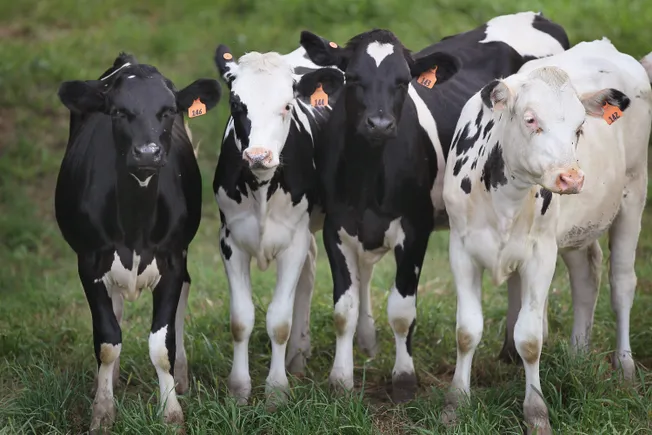An inside look at how Michigan is dealing with bird flu in dairy cows and humans

As questions swirl around bird flu, Michigan is doing things a bit differently. While criticism is mounting about a national response to the bird flu, other states grappling with the virus are looking at the Mitten state’s proactive approach to the outbreak in dairy cattle.
“If you don’t look for something you’re not going to find it,” said Natasha Bagdasarian, chief medical executive for the state of Michigan. “And I think the difference between what we’re seeing in Michigan and what other folks are seeing in other states is that we are looking for this virus.”
The state is offering free tests if symptoms develop and is using text messages and phone calls to check on farmers. Meanwhile, other states are ramping up their testing and setting new requirements to get a better handle on the virus. Iowa, for example, mandated dairy cattle be tested prior to participating in state fairs and exhibitions in late June. Colorado has offered similar guidance but no testing requirement.
After the cattle outbreak surfaced in late March, Michigan prioritized learning about different factors surrounding the H5N1 bird flu virus. The state emphasized testing and monitoring as many animals and people as possible.
“Michigan is looking more closely than a lot of other states,” said Lauren Sauer, who directs pandemic preparedness research at the University of Nebraska Medical Center’s Global Center for Health Security, according to the news site Stat. “They’re doing more surveillance in humans and animals so they’re finding more cases in humans and in animals. That tells me that we’re only finding things where we’re looking, and that’s not where we want to be.”
The efforts have led to an increase of detections in dairy herds across Michigan in April and May, with a total of 25 confirmed cases during the entire outbreak, according to the U.S. Department of Agriculture. Over the past month, however, only one case has been reported in the state as more detections appear in Colorado, Iowa and Idaho.
Last week, Colorado identified its first human case of bird flu linked to the cattle outbreak.The dairy worker reported having pink eye after exposure to sick cows in the northeastern part of the state. The person has since recovered. This marks the fourth known human detection of bird flu related to the virus infecting U.S. cattle.
“They’re testing more now,” Dr. Tim Boring, director of Michigan’s Department of Agriculture and Rural Development, said about the response of other states. “So they’re finding this disease, and they’re confirming it in places where it’s probably been for a little while.”
Boring said he’s talked with several other agencies about the challenges they’ve had building a response in real time with limited information.
“That’s certainly where we were in a lot of April through this,” he said. “Just understanding what the scope of the disease might be and what the transmission paths are looking like so we can craft a response to it.”
In addition to increased testing, Michigan has required dairies to adopt enhanced biosecurity practices, advanced epidemiology studies and offered farm workers thousands of dollars in incentives to participate in state and federal research.
Two Michigan residents have recovered after contracting the virus from sick cows earlier this year, prompting the state to move forward with a serology study to understand if there is any asymptomatic transmission happening at the farm level. There is even a bird flu hotline available in Spanish and Haitian-Creole languages for migrant workers to stay abreast of the outbreak.
One of the challenges state and federal agencies have encountered is the pace at which they’re handling the outbreak and getting people involved in studies and investigations. Of course, it’s important to work as fast as possible, Bagdasarian said, but in reality Michigan’s health and agriculture departments have to ensure everyone is comfortable with things before proceeding.
“That’s been our primary goal is to make sure that people feel comfortable with the direction we’re moving in and that folks feel that they can trust us with either information about their farms or information about their health, both of which can be highly confidential,” she said.
Part of the equation has been offering incentives to farmers with sick dairy cows. In May, the USDA established a financial assistance program to cover veterinary costs, compensate for milk production losses and encourage implementing biosecurity plans. However, the response has been lacking.
As of June 28, a spokesperson verified that 21 herds were enrolled in the USDA’s financial assistance program. There have been 139 confirmed cases in livestock herds over the span of the outbreak, according to federal data, with several unverified reports happening at the state levels. Only six herds have joined the department’s voluntary dairy herd status program, but there are “several more with significant interest.”
Criticism has mounted in the scientific community about the lack of data surrounding the current outbreak, raising concerns about what the response would be like if the virus was more severe.
“It’s been shocking to watch the ineptitude of just doing the surveillance, being able to talk about it, tracking the infections, understanding where we are,” said Seth Berkley, former CEO of Gavi, the Vaccine Alliance, according to Stat.
Meanwhile, the Michigan Department of Health and Human Services is testing blood samples from people who’ve volunteered for a seroprevalence study. The department is looking to share its findings in the near future.
“I’m hoping other states can take what we’ve stood up here in the last few weeks around a better understanding of the disease and use that as a tool to get a handle on it in their states as well,” Boring said.
Source: fooddive.com

